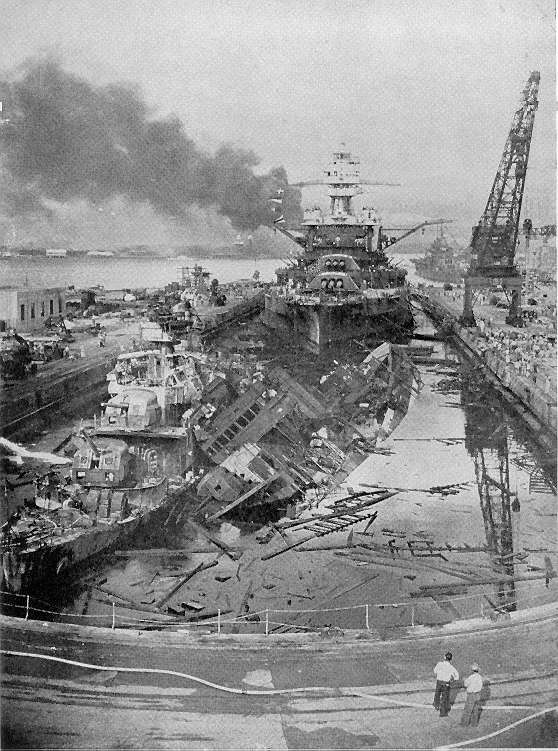|
|
| George Walters
- Pearl Harbor Crane Operator December 7, 1941 |
|
|
|
Obituary by Harold Morse,
Star-Bulletin (3/2/99)
George S. B. Walters, who used his huge crane to shield the Pacific Fleet flagship, the battleship Pennsylvania, from attacking enemy planes on Pearl Harbor Day, died Friday in Kaiser Hospital. He was 95. Some witnesses credited civilian Walters with saving the Pennsylvania and helping Navy gunners down eight to 10 attacking planes. As the attack went on, Walters continued to run his electrified crane back and forth along its track to keep it in the path of incoming bombers and use the boom as a pointer to warn gunners which direction planes were coming from. After a 500-pound bomb exploded nearby, damaging the crane and stunning Walters, he nearly fell from the crane. A Navy officer climbed up and tackled the staggering Walters, who knew nothing of what was going on until he awoke later in the base dispensary. Walters' crane may have contributed to the crash of an enemy plane, which appeared to damage its undercarriage on crane cables. He was told the plane crashed at Hospital Point below Aiea and that it hit a building on its way down. Walters had moved the crane just in time to avoid a direct hit from the bomb, which left a 17-foot crater. Walters later wondered how he survived. “Why God has protected me, I don't know,” he said. “But he must have had a reason.” Walters also was a clown and ringmaster with Shriners' clowns who entertained ill children and other groups for charity. He performed countless hours of volunteer work in various activities and was chosen as the outstanding male senior citizen for 1994 in the Mayor's Senior Recognition Program. His many interests included growing things. He learned to make compost, did planting and installed an irrigation system on a small plot. Born in Denver, Colo., his parents brought him to Hawaii when he was 14 months old. He first worked at Pearl Harbor in 1935, remaining a crane operator until 1950 and retiring from the shipyard as a supply technician in 1966. Most recently, he lived at Salt Lake. He is survived by sons Lewis and Dr. Wesley Walters; daughter Yvonne Walters-Dias; 12 grandchildren; and 20 great-grandchildren. Services will be at 10 a. m. Saturday at Oahu Cemetery Chapel. Call after 9 a. m. Graveside inurnment will follow. Casual attire. No flowers.
|
|
FROM CURSES TO PRAISES - Shipyard
Log
Shop 02 engineman George Waiters was operating a portal crane at Dry Dock 1 when the enemy planes came zooming out of the sky. Walters ran his travel-ing crane back and forth on its tracks, trying to shield the dry-docked battleship USS PENNSYLVANIA and destroyers CASSIN and DOWNES from low-flying attackers. Gunners on the port side of the PENNSYLVANIA cursed Walters at first, believing he was more of an interference than a help. Because their ship was in dry dock, they were below ground level and most of their view was blocked by the dry dock walls and nearby buildings. By the time they could see the planes, It was too late. Walters, however, perched high above the dry dock in the operator’s cabin the crane, had a bird’s-eye view. The gunners soon learned that the movements of the crane gave them an advance clue to the direction of the next oncoming plan Thanks to Walters, they were able to position their guns ahead of time and deliver more effective counterfire.
|
|
Thanks to Bob Mazurkiewicz for contributing the above. |
